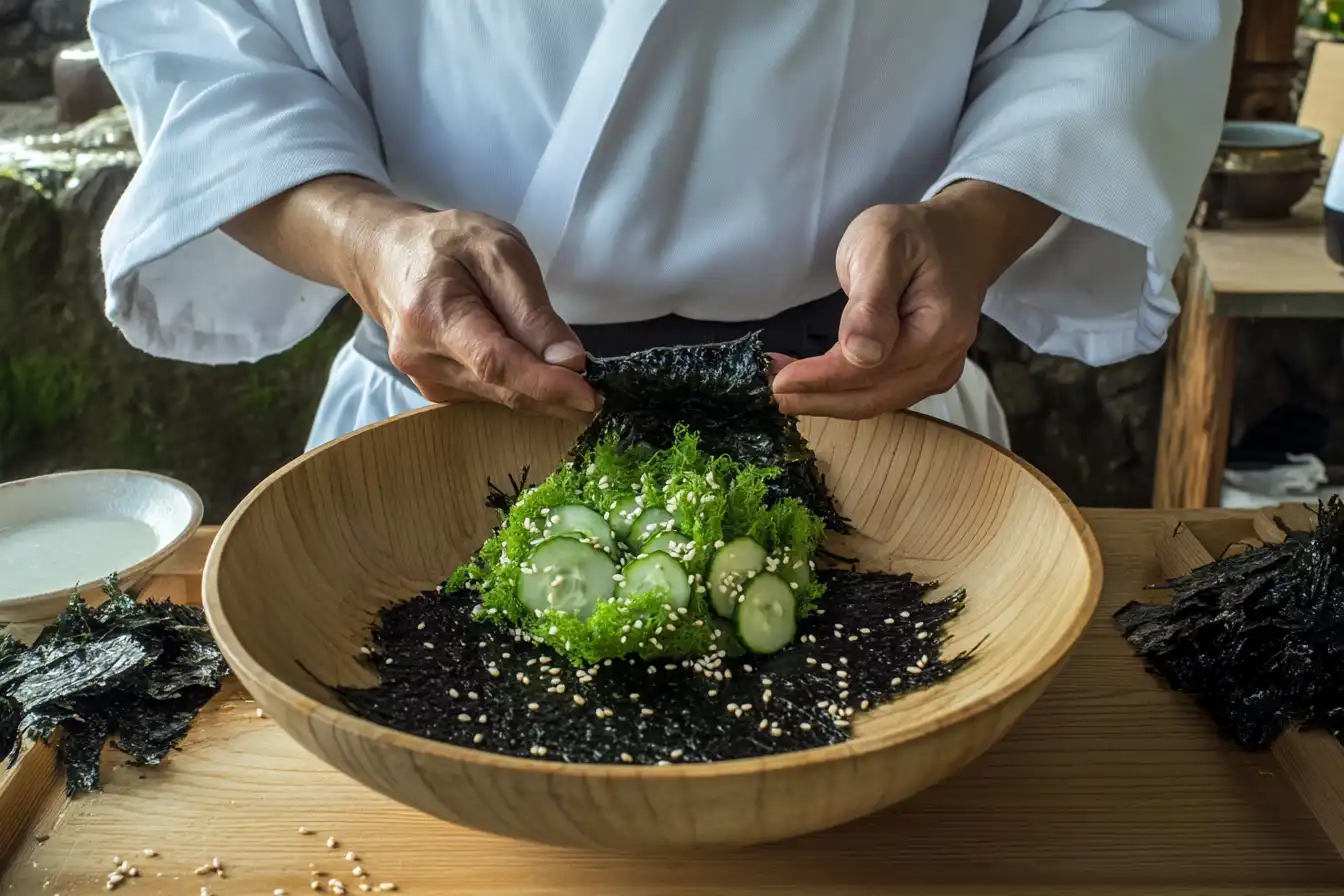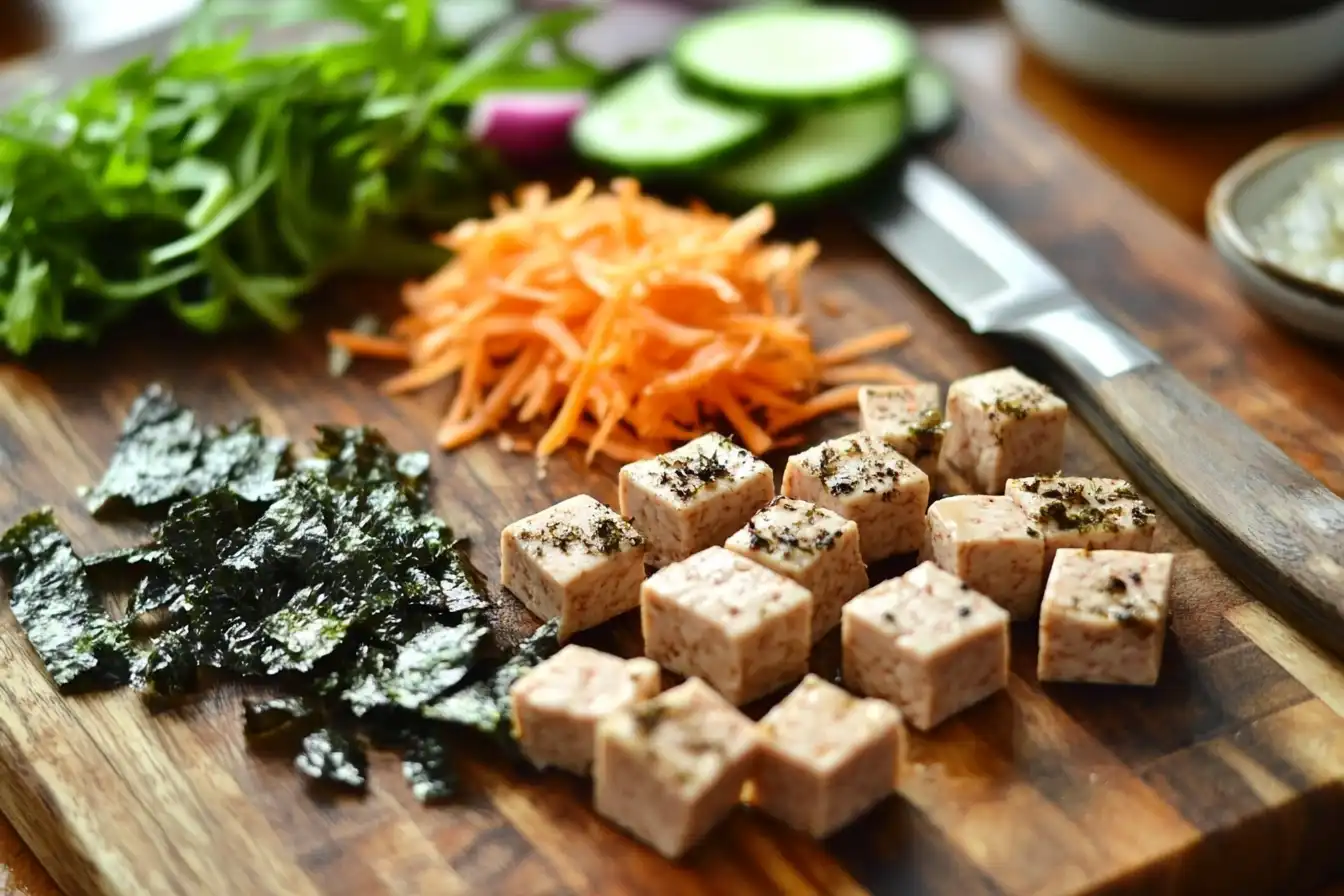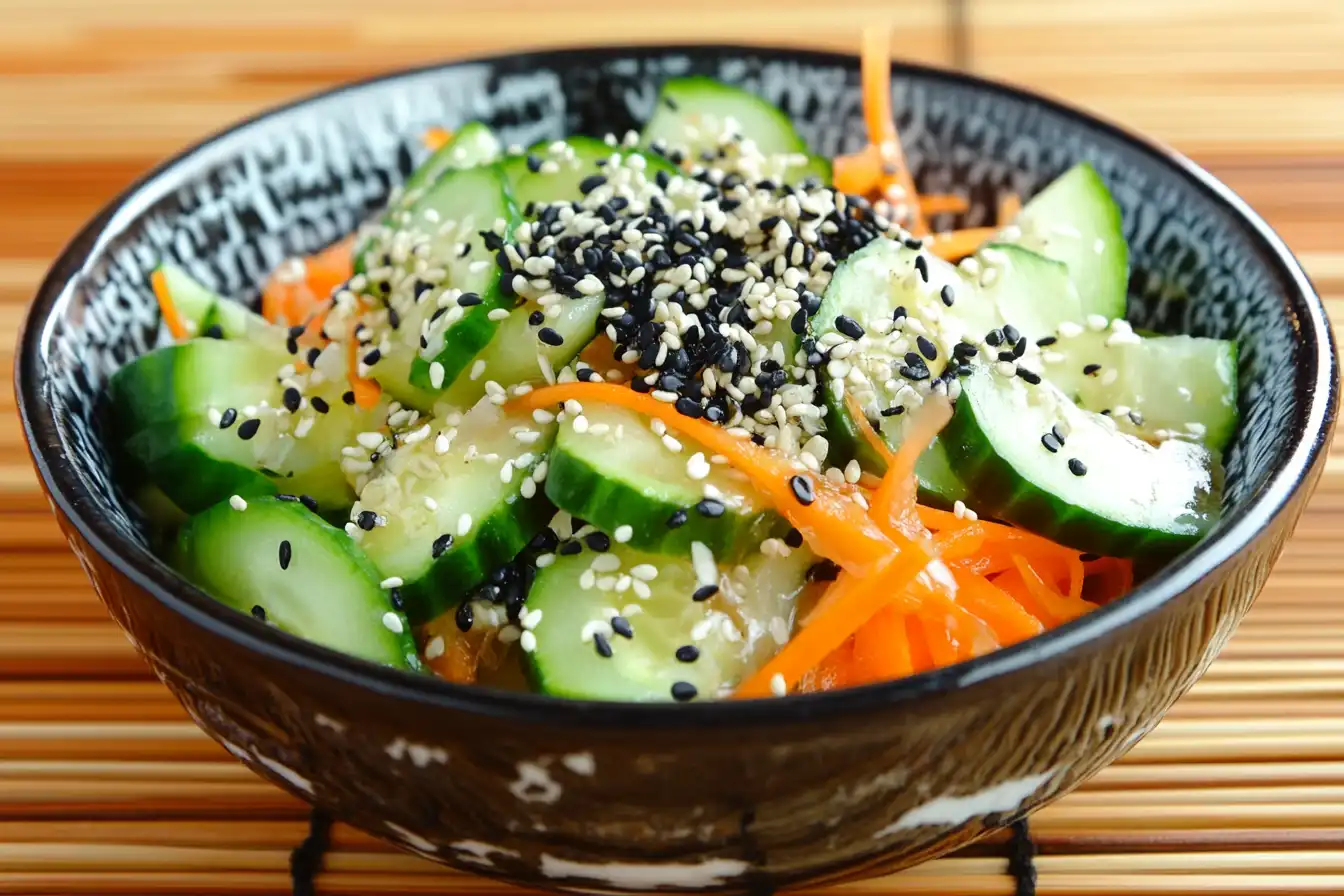Introduction
Japanese salads are a delightful exploration of flavors, textures, and cultural significance. They combine fresh ingredients, such as vegetables, seaweed, and tofu, with unique dressings that highlight traditional Japanese seasonings. Whether served as a refreshing side or a light main course, these salads not only showcase Japan’s culinary ingenuity but also offer incredible health benefits. In this article, we will dive deep into the world of Japanese salads, exploring their history, ingredients, and how to prepare them, ensuring a tasty and nutritious experience for all.
Understanding Japanese Salads
Historical Background of Japanese Salads
Japanese salads date back centuries, rooted in the country’s emphasis on fresh, seasonal produce and minimalism in culinary presentation. These salads evolved from Buddhist vegetarian traditions, where dishes emphasized simple ingredients prepared in ways that maintained their natural flavors. Over time, influences from other Asian cuisines introduced new vegetables and dressings, enriching the diversity of Japanese salads.
While early versions focused on pickled vegetables, modern Japanese salads often blend raw and cooked ingredients, showcasing vibrant colors and textures. This historical journey reflects the adaptability of Japanese cuisine, seamlessly incorporating traditional and modern elements.
Cultural Significance in Japanese Cuisine
In Japan, salads hold a unique place at the dining table. They symbolize balance, freshness, and respect for nature’s bounty. The use of seasonal vegetables, often tied to traditional festivals, adds layers of cultural importance. For instance, dishes like sunomono or vinegared salads are popular during summer, offering a cooling effect in the sweltering heat.
Additionally, Japanese salads are more than just side dishes. They’re an expression of omotenashi, the Japanese art of hospitality, showcasing meticulous care in preparation and presentation. Whether served in homes or high-end restaurants, these salads embody the essence of simplicity and elegance, hallmarks of Japanese cuisine.
Common Ingredients in Japanese Salads
Staple Ingredients in Japanese Salads
The foundation of Japanese salads lies in their diverse and fresh ingredients, chosen to complement both flavor and texture. Traditional recipes often highlight locally sourced vegetables, seafood, and seasonings that bring out umami, the fifth taste. These staple ingredients create harmony on the plate, ensuring each bite is as vibrant as it is nutritious.
Fresh Vegetables and Greens
Freshness is king when it comes to vegetables in Japanese salads. Crisp cucumber slices, shredded carrots, thinly sliced daikon radish, and tender mizuna greens frequently star in these dishes. Cucumber, for instance, adds a hydrating crunch, while daikon’s mild, peppery flavor balances the sweetness of dressings. Leafy greens like spinach or shiso (perilla leaves) bring earthy tones, enhancing both taste and presentation.
Seaweed Varieties
Seaweed is a quintessential ingredient, packed with nutrients and bursting with umami. Wakame, a popular choice, is often rehydrated and mixed into salads for its slightly sweet and briny flavor. Kombu, another favorite, is sliced thin and adds a chewy texture. These seaweed varieties not only add depth to the dish but also deliver incredible health benefits like iodine and fiber, making Japanese salads a nutritional powerhouse.
(Pro Tip: Learn more about the health benefits of seaweed in Japanese salads here.)
Noodles Used in Salads
Noodles are an unexpected yet delightful addition to many Japanese salads. Harusame (glass noodles), made from starch, provide a light and slippery texture that pairs well with tangy dressings. Soba noodles, crafted from buckwheat, are another popular choice, offering a nutty flavor that complements fresh vegetables. These noodles transform salads into hearty meals while maintaining their refreshing appeal.
Proteins: Tofu, Seafood, and Meats
Tofu, with its soft texture and ability to absorb flavors, is a staple protein in vegetarian Japanese salads. Seafood, like thinly sliced sashimi or kani (crab sticks), adds a luxurious touch. For non-vegetarian variations, grilled chicken or seared beef slices may be included, though always in moderation to maintain the salad’s lightness.
Each of these ingredients contributes not only to the visual allure of Japanese salads but also to their rich tapestry of flavors. In the next part, we’ll dive into the dressings that elevate these ingredients to culinary perfection!
Popular Japanese Salad Dressings
Traditional Japanese Salad Dressings
No Japanese salad is complete without its dressing—often the star of the dish. These dressings are renowned for their lightness and ability to bring out the natural flavors of the ingredients. Unlike heavier, cream-based Western dressings, Japanese varieties rely on simple, balanced combinations of soy sauce, sesame oil, rice vinegar, and mirin. They offer a perfect mix of savory, sweet, tangy, and nutty flavors, creating a harmonious experience with every bite.
Wafu Dressing
Wafu, which literally means “Japanese-style,” is a versatile dressing that embodies the essence of Japanese culinary traditions. Made with soy sauce, rice vinegar, mirin, and a touch of vegetable oil, it strikes a perfect balance between salty and tangy. Grated ginger and minced garlic are often added for depth, while sesame seeds provide a hint of nuttiness.
This dressing is light enough to enhance without overpowering and pairs beautifully with leafy greens, seaweed, or even noodle salads. The simplicity of wafu dressing makes it a staple in households and restaurants alike.
Sesame-Based Dressings (Goma-ae)
Goma-ae, meaning “sesame sauce,” is an absolute favorite in Japanese salads. Made by grinding roasted sesame seeds into a paste and blending them with soy sauce, sugar, and a dash of sake or mirin, this dressing is rich, creamy, and deeply satisfying.
It’s most famously paired with spinach to create the classic sesame spinach salad, but it also works wonderfully with other vegetables like broccoli or green beans. The nutty aroma of goma-ae adds a comforting warmth to any salad, making it a go-to choice for many.
Soy Sauce and Vinegar Combinations
Soy sauce and vinegar form the backbone of many Japanese salad dressings, offering a tangy kick with a savory twist. Rice vinegar, known for its mild sweetness, blends seamlessly with the saltiness of soy sauce, creating a delicate base for more complex dressings.
Variations might include a drizzle of sesame oil for nuttiness, a spoonful of honey for sweetness, or a splash of citrus juice (like yuzu or lemon) for a refreshing zing. These combinations are particularly popular in sunomono (vinegared salads), where they complement light ingredients like cucumbers or wakame.
Each dressing is a masterpiece of balance, enhancing the ingredients it accompanies without overwhelming them. Up next, we’ll explore some iconic Japanese salads that showcase these dressings to perfection!
Iconic Japanese Salad Varieties
Signature Japanese Salads
Japanese salads are as diverse as they are flavorful, showcasing an array of textures, colors, and ingredients. From light and tangy vinegared salads to creamy potato-based favorites, these iconic dishes represent the versatility and creativity of Japanese cuisine. Each variety highlights a unique combination of ingredients and dressing, offering something for every palate.
Sunomono (Vinegared Salads)
Sunomono, meaning “vinegared things,” is a refreshing salad that often features thinly sliced cucumbers, wakame, and occasionally seafood such as shrimp or octopus. The salad is dressed in a simple mixture of rice vinegar, sugar, and soy sauce, creating a tangy and slightly sweet flavor profile.
The crisp texture of cucumbers paired with the subtle chewiness of seaweed makes sunomono a perfect appetizer or side dish. It’s especially popular in summer due to its cooling properties and lightness.
Goma-ae (Sesame Spinach Salad)
A classic among Japanese salads, goma-ae is as simple as it is flavorful. This dish typically features blanched spinach coated in a rich, nutty sesame dressing made from ground sesame seeds, soy sauce, and sugar.
The soft texture of the spinach contrasts beautifully with the slightly gritty, aromatic dressing, creating a dish that’s both comforting and elegant. Goma-ae is a staple in traditional Japanese meals and a favorite for those seeking a quick, healthy salad option.
Harusame Salad (Glass Noodle Salad)
This colorful salad features harusame, or glass noodles, which are made from mung bean starch and have a translucent appearance. These noodles are paired with julienned vegetables like carrots, cucumbers, and sometimes thinly sliced ham or egg strips for added protein.
The dressing, a light soy-vinegar blend with a hint of sesame oil, ties the ingredients together. The slippery texture of the noodles combined with the crunch of fresh vegetables makes harusame salad an exciting dish, perfect for potlucks or picnics.
Kani Salad (Crab Salad)
Kani salad, featuring imitation crab sticks (surimi), is a popular choice in Japanese-inspired fusion cuisine. The shredded crab is combined with julienned cucumber, thinly sliced carrots, and sometimes sweet corn, then tossed in a creamy, tangy dressing made from Japanese mayonnaise, soy sauce, and a touch of rice vinegar.
The result is a flavorful and satisfying salad that’s slightly sweet, savory, and crunchy. Often garnished with tobiko (fish roe) or sesame seeds, kani salad is a visually appealing dish that’s as delicious as it looks.
Japanese Potato Salad
Japanese potato salad puts a unique spin on the classic dish. It features mashed or partially mashed potatoes mixed with thinly sliced cucumbers, carrots, and sometimes boiled eggs or ham. The dressing, made from Japanese mayonnaise, gives it a creamy texture with a hint of sweetness.
The addition of crunchy vegetables provides a delightful contrast to the smooth potatoes, making this salad a comforting yet refreshing side dish. Its versatility allows it to pair well with various main courses, from grilled fish to fried chicken.
These iconic Japanese salads showcase the culinary diversity and ingenuity of Japan. Up next, we’ll uncover the impressive health benefits of incorporating these salads into your diet!
Health Benefits of Japanese Salads
Nutritional Advantages of Japanese Salads
Japanese salads are celebrated not only for their vibrant flavors but also for their impressive health benefits. By emphasizing fresh, seasonal ingredients and light, nutrient-dense dressings, these salads offer a guilt-free way to indulge in delicious food. They cater to various dietary needs and provide a treasure trove of nutrients, making them a fantastic choice for anyone seeking a balanced and healthy diet.
Rich in Vitamins and Minerals
Packed with fresh vegetables like cucumbers, spinach, and carrots, Japanese salads are an excellent source of essential vitamins and minerals. Spinach, for example, provides a hefty dose of iron and vitamin C, while carrots contribute beta-carotene, which supports healthy vision. Seaweed, a common ingredient, is rich in iodine, magnesium, and calcium, which are crucial for thyroid health and strong bones.
These salads are a simple yet effective way to boost your daily nutrient intake without resorting to supplements, thanks to their reliance on wholesome, natural ingredients.
Low in Calories and Fats
Unlike many Western salads drenched in creamy dressings, Japanese salads rely on light, oil-free dressings made from soy sauce, rice vinegar, or sesame oil. These dressings enhance flavor without adding unnecessary calories or unhealthy fats.
The fresh vegetables, seaweed, and lean proteins commonly found in these salads make them a low-calorie option that doesn’t skimp on taste. Whether you’re managing your weight or simply aiming for a balanced diet, Japanese salads are a satisfying choice that won’t weigh you down.
Benefits of Fermented Ingredients
Fermented ingredients like miso and pickled vegetables are frequently featured in Japanese salads, providing an extra layer of health benefits. Fermented foods are rich in probiotics, which promote gut health and improve digestion. They also support a healthy immune system and help maintain a balanced microbiome.
For instance, miso-based dressings not only add a savory depth of flavor but also deliver beneficial bacteria that can enhance overall well-being. Incorporating these ingredients into your meals can have a long-lasting positive impact on your health.
From their vitamin-packed vegetables to their gut-friendly fermented elements, Japanese salads are as nutritious as they are delicious. In the next section, we’ll guide you through preparing these incredible dishes at home, so you can enjoy their benefits firsthand!
Preparing Japanese Salads at Home
Making Japanese Salads at Home
Creating Japanese salads at home is an enjoyable way to experiment with fresh ingredients and traditional flavors. These salads are surprisingly easy to prepare, requiring only a few specialized tools and authentic ingredients. By following a clear preparation guide, even beginners can craft visually stunning and delicious dishes that rival those found in authentic Japanese restaurants.
Essential Tools and Equipment
The right tools can make preparing Japanese salads both efficient and enjoyable. A few key items to keep on hand include:
- Mandoline slicer: Perfect for thinly slicing cucumbers, carrots, and radishes to achieve the uniformity seen in traditional salads.
- Japanese mortar and pestle (Suribachi and Surikogi): Ideal for grinding sesame seeds to create creamy dressings like goma-ae.
- Sharp knives: High-quality Japanese knives (e.g., Santoku) make precision cutting effortless.
- Salad spinner: Ensures greens are dry and crisp, allowing dressings to adhere evenly.
These tools not only save time but also enhance the authenticity and presentation of your salads.
Sourcing Authentic Ingredients
Finding authentic ingredients is essential to replicating the unique flavors of Japanese salads. Fortunately, many of these items are now widely available in Asian markets and online stores. Key ingredients to stock up on include:
- Vegetables: Fresh options like daikon radish, mizuna greens, and cucumbers.
- Seaweed: Dried wakame or kombu for rehydration and use in salads.
- Condiments: Soy sauce, mirin, rice vinegar, and sesame oil for dressings.
- Proteins: Tofu, imitation crab, or sashimi-grade seafood.
- Noodles: Harusame (glass noodles) or soba for heartier salads.
Shopping from trusted sources ensures the ingredients retain their authentic taste and quality, laying a solid foundation for your dishes.
Step-by-Step Preparation Guide
- Prepare the ingredients: Wash and dry vegetables thoroughly. Use a mandoline slicer or knife to create thin, even slices. Rehydrate dried seaweed by soaking it in water for a few minutes.
- Make the dressing: Whisk together your chosen ingredients, such as soy sauce, rice vinegar, and sesame oil, in a small bowl. For sesame-based dressings, grind sesame seeds to a paste before mixing.
- Assemble the salad: Arrange vegetables, seaweed, and proteins attractively in a large bowl. Add noodles or potatoes for heartier variations.
- Toss or drizzle: Lightly toss the salad with dressing or drizzle it over the top for a more layered presentation.
- Garnish and serve: Sprinkle sesame seeds, nori strips, or a pinch of tobiko for an extra pop of flavor and color.
With these steps, you can bring the vibrant world of Japanese salads into your kitchen. Up next, we’ll explore how these dishes have found their place in modern cuisine and global dining trends!
Japanese Salads in Modern Cuisine
Japanese Salads in Contemporary Dining
As the world continues to embrace global flavors, Japanese salads have found their way into modern dining, blending tradition with innovation. From upscale restaurants to casual eateries, these salads have become a symbol of freshness, health, and culinary creativity. Their versatility allows them to seamlessly integrate with diverse cuisines while maintaining their authentic essence.
Fusion with Western Dishes
The fusion of Japanese and Western cuisines has given rise to exciting new interpretations of traditional Japanese salads. For instance, classic salads like sunomono are paired with grilled salmon, while creamy Japanese potato salad is used as a filling for sandwiches.
One popular fusion dish is the Japanese Caesar salad, featuring miso-based dressing and toppings like nori strips and sesame seeds instead of croutons. By combining familiar Western elements with Japanese ingredients, these creations cater to a broader audience while offering a fresh twist on beloved classics.
Popularity in Global Restaurants
The increasing demand for healthy and unique dishes has propelled Japanese salads onto the menus of restaurants worldwide. Dishes like kani salad and goma-ae have become staples in sushi bars and Asian-fusion eateries.
Restaurants often elevate these salads by incorporating premium ingredients like sashimi-grade tuna or exotic toppings such as yuzu zest. Their aesthetic appeal, thanks to vibrant colors and meticulous plating, makes them a favorite for social media food enthusiasts. This widespread popularity underscores the universal allure of Japanese salads.
Adaptations for Dietary Preferences
With growing awareness of dietary preferences and restrictions, Japanese salads have been adapted to suit various lifestyles. For instance:
- Vegetarian options: Substituting seafood with tofu or mushrooms ensures these salads remain plant-based.
- Gluten-free variations: Using tamari instead of soy sauce caters to those with gluten sensitivities.
- Low-carb choices: Replacing noodles with spiralized vegetables like zucchini aligns with keto or low-carb diets.
These adaptations maintain the essence of Japanese salads while making them accessible to a wider audience. Whether you prefer vegan or high-protein meals, there’s a Japanese salad variation tailored to your taste.
By evolving with modern trends, Japanese salads have solidified their place in contemporary cuisine, offering endless opportunities for experimentation. Next, we’ll address some frequently asked questions to wrap up this comprehensive guide!
Frequently Asked Questions About Japanese Salads
FAQs on Japanese Salads
Curious about the essentials of Japanese salads? Whether you’re exploring their ingredients, preparation, or health benefits, this section answers the most common questions, helping you deepen your understanding and appreciation of these versatile dishes.
What are common ingredients in Japanese salads?
Japanese salads are renowned for their fresh and diverse ingredients. Staples include crisp vegetables like cucumbers, carrots, and daikon radish, along with leafy greens such as spinach or mizuna. Seaweed varieties like wakame and kombu add unique textures and flavors, while proteins like tofu, crab sticks, or sashimi-grade fish enhance the dish.
Dressings, which often feature soy sauce, rice vinegar, and sesame oil, tie these ingredients together with a perfect balance of umami, tang, and nuttiness. The inclusion of simple, wholesome elements reflects the traditional emphasis on freshness and seasonality.
How do Japanese salad dressings differ from Western ones?
Japanese salad dressings are lighter and more balanced compared to many Western varieties. While Western dressings often rely on oils, creams, or dairy for richness, Japanese dressings use simple, umami-packed ingredients like soy sauce, rice vinegar, and miso paste.
For example, wafu dressing combines soy sauce and rice vinegar for a tangy, savory flavor, while goma-ae is a sesame-based dressing that’s creamy yet light. These dressings enhance the natural flavors of the ingredients without overpowering them, making them ideal for salads centered on fresh produce.
Are Japanese salads typically served as main dishes or sides?
Traditionally, Japanese salads are served as side dishes, complementing mains like grilled fish, rice, or tempura. However, with the addition of proteins such as tofu, seafood, or chicken, they can easily transition into light yet satisfying main courses.
For instance, a harusame salad with glass noodles and prawns or a protein-rich kani salad can serve as a standalone meal. Their versatility allows them to fit into various meal formats, whether part of a multi-course dinner or a quick, healthy lunch.
Can Japanese salads be made vegan or vegetarian?
Absolutely! Many Japanese salads are inherently vegetarian or can be adapted to vegan diets with simple substitutions. For example, tofu or mushrooms can replace seafood, while plant-based soy sauce alternatives can be used for dressings.
Seaweed, vegetables, and plant-based proteins are staples in many traditional recipes, making these salads naturally vegan-friendly. Options like goma-ae or cucumber sunomono are excellent examples of plant-based Japanese salads bursting with flavor.
What are the health benefits of eating Japanese salads?
Japanese salads are a powerhouse of nutrition. Packed with vitamins, minerals, and fiber from fresh vegetables and seaweed, they support overall health. Low-calorie dressings keep the fat content minimal, while fermented ingredients like miso or pickled vegetables contribute probiotics for gut health.
Their high nutrient density and emphasis on fresh, wholesome ingredients make them ideal for those seeking a balanced diet. From improving digestion to supporting immunity, these salads offer a wide array of health benefits.
How can I make Japanese salad dressings at home?
Making Japanese dressings at home is simple and rewarding. For a classic wafu dressing, combine soy sauce, rice vinegar, sesame oil, and a touch of sugar. To create goma-ae, grind sesame seeds into a paste and mix with soy sauce, mirin, and sugar for a creamy, nutty flavor.
Experiment with ingredients like yuzu juice, ginger, or miso paste to customize your dressings. With just a few pantry staples, you can replicate the authentic flavors of Japanese salads in your kitchen.
These FAQs address common curiosities about Japanese salads, helping you enjoy these dishes with newfound confidence and insight!



